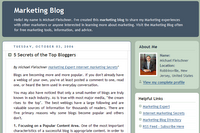Adapted from
Brad CallenBased on our last post (dated October 15, 2006), we've selected our main 3 keywords we'd like to target. In this example, they are:
* weight loss story
* weight loss picture
* safe weight lossNotice that all of the keywords contain the word "weight loss". This will make things easier for us when we begin to optimize our offpage ranking factors which you'll learn about later.
Let's Optimize Our Webpage ...The first thing we need to do is select a page Title for our website.
Add a TitleThe page title should:
Include ONLY our main keywords. The least amount of words you can place in the title, the more weight Google will give to each of the keywords and the higher you will rank.
Note: When I say "Google", I'm really referring to all the major engines (Google, Yahoo, and MSN). But I am saying Google because this is the search engine you should really focus on optimizing for because Google gets roughly 50% of all the searches on the web. Yahoo receives about 30% and MSN about 20%.
When creating your page title, it should not look like this:
* Welcome to our website!
* This is the html code used to create this title: Welcome to our website!
It should not even look like this, which does contain our main keywords, but contains an unnecessary number of words:
* weight loss story and weight loss picture and safe weight loss
* This is the html code used to create this title: weight loss story and weight loss picture and safe weight loss
Although that title isn't horrible and does contain all of your main keywords, you should do a couple of things to cut down on words used.
This would be a perfect title for your webpage:
* Weight Loss Story Safe Weight Loss Picture
* This is the html code used to create this title: Weight Loss Story Safe Weight Loss Picture
Notice that I've:* Taken out all of the "ands"
* Replaced one of the "ands" with a "" character (Note: You can add this character by holding the shift key on your keyboard and pressing the backslash key above the enter key.)
* Combined the keywords "Safe Weight Loss" with "Weight Loss Picture"
Always Combine Your Keyword When Possible to cut down on the total number
of words that are in your title!
Always Combine Your Keywords In The Page Title!When Google looks at our title, it will see all 3 of our keywords only. Combining keywords to cut down on the total number of keywords displayed in the title is a great way to boost the strength of each individual keyword, which will have an immediate impact on your ranking.
Add h1 header tagsNext we'll need to add one h1 header tag and place our most important keyword there.
The h1 header tag should be as far towards the top of the page as possible. When Google reads a webpage, it views the text from the top left hand side of the page to the bottom right hand side of the page.
Note: Here's a neat free tool which allows you to visually see how the search engines view your webpage:
http://www.webmaster-toolkit.com/search-engine-simulator.shtmlSo, it's best to place your h1 header tag on the top left hand or top/middle portion of your page. You can think of an h1 header tag as a title for whatever content you have on your page.
For example, the h1 header tag of this lesson would be:
"How changing 1 onpage optimization factor can boost your rankings by
over 350 positions!"... and the html code would look like this:
h1 How changing 1 onpage optimization factor can boost your rankings by over 350 positions! /h1
Of course, I would have changed my lesson title to contain my main keyword if I was actually trying to optimize this page for Google. Also, if possible, it's ideal if you can include ONLY your main keyword within the h1 header tags. Weight Loss Story would be perfect.
Add h2 header tagsNext, we'll need to create an h2 header tag. This can be thought of as a sub heading for our webpage. You should place your 2nd most important keyword in the h2 header tag. The h2 tag should be placed somewhere towards the top half of your webpage.
A good h2 header tag for our example would be:
* safe weight loss (Usually it's best to place your primary keyword in your h1 tags and your secondary keyword into the h2 tags.
After we've done this, we need to actually create the content for our webpage. When writing the content, try to evenly sprinkle your main keywords throughout the copy. Don't overdo it though.
Try to mention each keyword in a natural way as you are writing, but be sure to include at least one of the keywords per 1-2 paragraphs, depending on how large your page is.
Tip: Make sure to mention your main keyword at the very top left and the very bottom right hand side of the webpage. A trick I like to use is to include this in the copyright information line at the bottom of the website. For our example, this would be a good example:
© 2005 copyright www.domain.com a weight loss story
Notice that it flows and doesn't really look too strange.
Bolding, italicizing and underlining ...Once we've finished writing the copy, we should go through and bold, underline, or italicize some of the keywords only 1 time each, maximum. Only do 1 per keyword or it will hurt you more than it helps. This isn't crucial to do, but it's good to maybe do this to a couple keywords...
Properly include "alt" image tags ...Next, click on the very top image of your webpage (This is usually your website's header graphic) and include an "alt" image tag using the text "weight loss story header" if you're adding this alt text to your website header graphic. Click on 2 more graphics throughout your webpage and enter your other 2 keywords, plus an extra word like "graphic" or "image"... For example, we would use "weight loss picture graphic" and "safe weight loss image". This ensures that Google won't view this as spam.
For example, if we have an image on our webpage called: picture1.jpg
The code that would be used to insert the image would look something like this:
img height="1" src="picture1.jpg" width="1" border="0"
Now, if we were to add an alt image tag called "Weight Loss Story Graphic", we'd simply do this:
img height="80" alt="Weight Loss Story Graphic" src="picture1.jpg" width="250" border="0"
Force Google To Read Your Keywords First!Now, remember I stated above that Google views your webpage from top left, to bottom right? Well, in general they do. But because most websites contain a left hand column which contains all of their navigation links...
Google WILL View all of the text in the left hand column Before The Body of the webpage
To show you what I mean, look at the image below to see the order of information that Google will view this webpage. because of the way the person has created the tables containing their content. I've added red lines so you can visually see the way the site was designed, has they not made the table borders invisible.

How can you get around this? I've come up with a neat little trick that will ensure that Google reads the actual body of your webpage before the left hand column containing your navigational links.
Here is what you need to do:
Rather than creating a table that looks like this:

See how I've changed the website above, so that Google now sees our content BEFORE our navigation menu:

By doing this, Google will read the top left hand row/column first... BUT will see that it is empty or only contains a couple words in this case, so it will then read the body of your webpage and then read the 2nd left hand row/column which contains your navigational links! :-)
That's all there is to it!
In summary, I really want to point out the fact that, although good onpage optimization is something you'll really want to do, it is
NOT how you make dramatic changes in your search engine ranking!
Important! Let me repeat that again, onpage optimization... which is what I've taught you thus far, will make small changes in your ranking, but WILL NOT help your site make dramatic jumps in ranking.
This is one of the biggest misconceptions in the search engine world. Many believe that by getting your keyword density just right, or by moving your keywords around on the page in just the right places, you'll really move up in the search engines.
That is not the case at all. It is the offpage optimization factors that will get you high rankings. I will teach you exactly what offpage optimization factors are, AND how to make sure you optimize these factors perfectly for Google!
All the best,
Brad Callen
Professional SEO
SEO Elite:
SEO Software





 Marketing Blog founder and top-selling author Michael Fleischner has been featured on The TODAY Show, ABC World News, and Bloomerg Radio.
Marketing Blog founder and top-selling author Michael Fleischner has been featured on The TODAY Show, ABC World News, and Bloomerg Radio. 